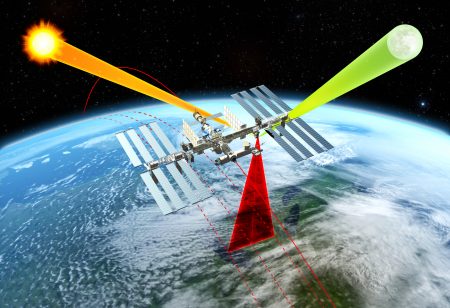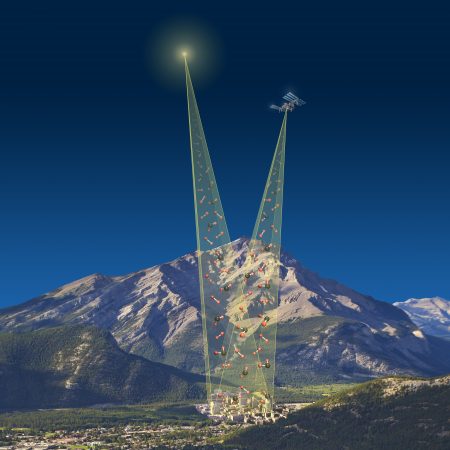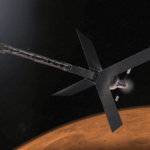September 29, 2018 – The CLARREO project, one of several targeted to be cut by the climate change denial Trump administration has continued to proceed despite attempts to cut its budget. Planned for deployment on the International Space Station (ISS) by 2o23, the U.S. Congress recently approved funding with NASA awarding the contract to build it to the Laboratory for Atmospheric and Space Physics at the University of Colorado-Boulder.
CLARREO stands for the Climate Absolute Radiance and Refractivity Observatory. It is designed to provide a decadal-long study of Earth land, ocean, and atmospheric changes using an instrumentation package to measure radiative forcings, climate responses, and climate feedback. It fills in the blanks that still exist for climate modeling to become even more accurate. CLARREO instrumentation includes:
- infrared spectrometer – to measure infrared radiance emitted by Earth into space.
- reflected solar imaging spectrometer – to measure the heat island effect of solar radiation trapped within the Earth’s atmosphere.
- global navigation system radio occultation receiver – to measure the refractivity of the atmosphere related to pressure, temperature, and water vapour.
CLARREO Pathfinder is part of the project and has survived Trump-attempted cuts. Pathfinder is designed to enhance existing Earth-observation done by a number of existing NASA satellites measuring changes in the Earth’s atmosphere. With it, scientists will be able to measure how clouds respond to climate change, currently an uncertain aspect within models.

And then there is the Orbiting Carbon Observatory-3 (OCO-3), the third iteration of a CO2-space-based monitoring project that the Trump administration has repeatedly attempted to kill through budgetary cuts. Congressional advocacy has kept it alive.
In 2009 the original Orbiting Carbon Observatory was destroyed in a launch failure. Its successor, the Orbiting Carbon Observatory-2 (OCO-2) satellite made it to orbit in 2014 where it began to collect global measurements of atmospheric carbon dioxide (CO2). The satellite created an accurate picture of the spatial distribution of CO2 over the entire planet giving climatologists a better understanding of processes needed for regulating this greenhouse gas (GHG), and for predicting future CO2 increases and impacts on Earth’s climate.
OCO-3 has not survived as a stand-alone satellite. Instead, it will be a payload item delivered to the ISS as s package in February of 2019 where it will be deployed. OCO-3 doesn’t measure CO2 directly but rather looks at the intensity of sunlight reflected from the presence of CO2 in the atmosphere. Spectrometers will measure inbound and reflected light and analyze the spectral pattern the diffracted wavelengths create. The instrumentation can detect 17,500 different colours in the light spectrum. The light passing through the air column is altered by the concentration of CO2 (A-band Weak CO2, and Strong CO2) and molecular oxygen (O2) which shows up in subtle changes to three specific Near Infrared (NIR) wavelengths which are then measured by a sophisticated computer program. The weak Co2 band is most sensitive to the gas concentrated near the surface. The O2 A-band spectra indicate the presence of clouds. And the strong CO2 wavelength is present with polluting aerosols. On the ISS, OCO-3 will observe the Earth doing approximately 16 orbits each day.

A mission that hasn’t survived the cut so far is known a PACE which stands for Plankton, Aerosol, Cloud, ocean Ecosystem) and is designed to monitor the food chain and health of the world’s oceans by focusing on phytoplankton populations. By measuring the ocean’s smallest life scientists have hope that they will develop a better picture of how changes to the ocean environment will affect fisheries and climate. The timeline for this project was a launch date of 2022. It may need a change in administration to get off the cutting floor.
Then there is DSCOVR, a satellite already in orbit that is studying space weather on the one hand, and with a second set of instruments aimed at Earth, focusing on the energy balance of our planet, measuring ozone, aerosols, and ultraviolet radiation at the surface. The latter side of the satellite’s instrumentation is called EPIC, standing for Earth Polychromatic Imaging Camera, which currently is sending imaging and data to the planet, but with funding cuts, has no one doing the analysis of what has been observed.
Add to the list RBI (Radiation Budget Instrument) which has been scheduled for a 2021 launch. Standing for Radiation Budget Instrument, this instrumentation package was to fly on the Joint Polar Satellite System-2 (JPSS-2). RBI would have measured the effect of clouds on Earth’s energy balance, weather, and climate. But it has been axed from the mission by a Trump budget cut.
Meanwhile, the Trump administration is gung-ho on getting Americans back on the Moon, creating a military SpaceForce, and planning to colonize Mars. It’s Earth that’s being left wanting as the planet deals with an excess of human-generated GHGs in the atmosphere and oceans. It all makes perfect sense if you continue to claim that climate change is a hoax perpetrated by the Chinese government.
It cannot be emphasized enough, any climate change-focused mission lost today represents a danger to the planet’s future. It may be true that some of these missions are collecting overlapping data although by using different experiments to gather the evidence. But if so, research here on Earth can be accused of doing the same thing for corroborative and evidentiary purposes. It is certain that the cuts mean researchers are losing precious time to perfect their science, share their knowledge, and contribute to policies for effective mitigation and adaptation.
States Kim Cobb of Georgia Tech, “I can’t overstate the urgency to learn all that we can about climate change now.” A four-year delay (assuming Trump is defeated in 2020 by a President who believes climate change is human-caused and real) to any project focused on the subject is seen by most who study it to be an enormous setback. Cobb points out, “We needed them [the satellites and data-gathering instrumentation] 20 years ago.”
The American public is very much on the side of science with this issue. A recent Bloomberg poll showed that 43% picked observing climate as NASA’s top priority. That same poll showed that only 3% thought NASA’s top focus should be on a return to the Moon, while 8% stated a human voyage to Mars or other planets should be the agency’s top priority.















